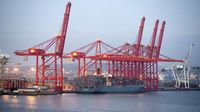South Africa is grappling with a significant economic crisis, marked by sluggish growth and a troubling infrastructure deficit, particularly in energy and logistics. The nation, which remains Africa’s largest economy, has seen its economic growth stagnate since 2008, failing to meet expectations while lagging behind many of its peers. Global inflation, energy shocks, currency volatility, and high interest rates have compounded the issues, leading to stagflation, soaring unemployment, and rising inflation rates.
According to a report by the World Bank, South Africa ranked 80th out of 170 nations for productivity growth from 2015 to 2021. During this period, the country’s productivity—measured as GDP per employed person—grew at only two-thirds of the global average. This stagnation is particularly concerning as higher productivity is essential for buffering economies against shocks and facilitating recovery, ultimately raising wages and improving living standards.
Persistent issues such as load-shedding and logistical bottlenecks have impeded South Africa's productivity for over 15 years. While the easing of load-shedding may offer some respite, logistical challenges remain significant. Transnet, the state-owned freight transport and logistics company, has seen inefficiencies that have placed South Africa's ports among the worst globally, with Cape Town ranking last out of 405 ports in the World Bank’s Container Port Performance Review. Four of the country’s ports feature in the bottom 15 by performance indicators, highlighting a critical need for reform.
As the government faces mounting pressure to refocus on economic growth, it must also repair its strained relations with the United States while strengthening ties with the European Union to bolster exports. South Africa’s industrial policy has overly emphasized localization and sectoral protection, often at the expense of export-driven expansion. By failing to embrace global markets, the country has ceded ground to competitors and lost the battle for export-led growth.
Over the past seven years, South Africa’s GDP growth has averaged a mere 0.8% annually, underscoring the urgent need for a new growth model. This model should pivot towards export-led growth, as productivity—rather than labor or capital accumulation—will be the primary driver of long-term prosperity. To boost productivity, South Africa needs to revise its trade policies. Growth will not come from shielding local industries from competition but from fostering global competitiveness.
The World Trade Organization’s trade liberalization policies have enabled technological transfer and innovation, yet South Africa has failed to capitalize on these opportunities. Instead, the government has resorted to tariffs and subsidies that provide short-term relief but hinder long-term progress. Sustainable growth requires a robust manufacturing sector capable of competing globally, yet manufacturing currently accounts for just 30% of exports in South Africa—an alarmingly low figure for a nation seeking industrialization.
South Africa represents a mere 0.6% of global GDP, and focusing solely on the domestic market ignores vast opportunities in international trade. Beyond trade policies, the country must address its infrastructure deficit, particularly in energy and logistics. Eskom’s failures have significantly hampered industrial productivity, while Transnet’s inefficiencies have crippled trade. Without significant investment in energy security, rail networks, and port facilities, South Africa will struggle to compete in global markets.
Innovation is another area requiring urgent attention. South Africa has lagged in research and development, with limited government incentives for technological advancement. A shift towards digitalization, automation, and artificial intelligence could unlock significant productivity gains. The government must encourage private-sector investment in these areas while improving the country’s education and skills base to match the needs of a modern economy.
Ultimately, productivity is the most reliable driver of long-term economic growth. It enhances per capita income and defines a nation’s ability to innovate, invest, and convert inputs into higher-value outputs. Failure to act decisively will only entrench the country’s economic stagnation further. The government must abandon macroeconomic gimmicks in favor of a coherent, long-term growth strategy, which requires structural reforms, improved governance, and a renewed commitment to integrating South Africa into the global economy.
In a related development, Public Works and Infrastructure Deputy Minister Sihle Zikalala is set to hold a stakeholder consultation in Port St Johns, Eastern Cape, on April 11, 2025, as part of efforts to develop a small harbor in the area. This initiative aims to create jobs and stimulate the local economy. Zikalala will be joined by Eastern Cape Public Works and Infrastructure MEC Siphokazi Lusithi, Port St Johns local Municipality Mayor Cebisa Mazuza, and Eastern Cape Chair of the House of Traditional Leaders Mpumalanga Gwadiso.
The Department of Public Works and Infrastructure has identified Port St Johns, Port Shepstone in KwaZulu-Natal, and Port Nolloth in the Northern Cape for small harbor development. Last month, Public Works and Infrastructure Minister Dean Macpherson and Saldanha Bay Mayor André Truter committed to redeveloping the St Helena Bay and Saldanha Bay small harbors, which have fallen into disrepair and often attract criminal activity, deterring investment in surrounding communities.
As South Africa seeks to overcome its economic challenges, the focus on infrastructure development, particularly in coastal areas, may provide a much-needed boost to local economies and employment opportunities. However, the broader economic landscape remains precarious, necessitating urgent and effective policy measures to enhance productivity and competitiveness on a global scale.






